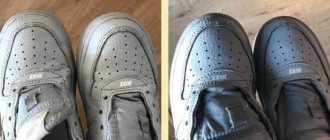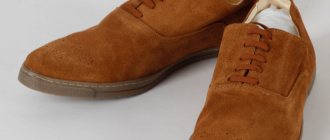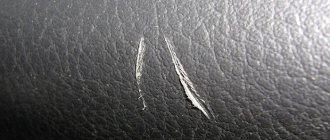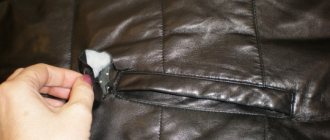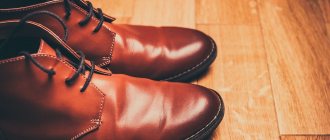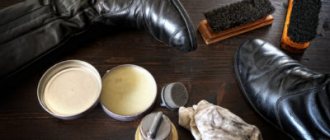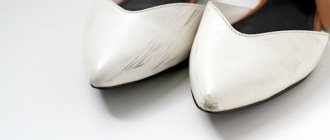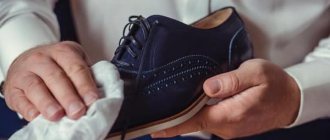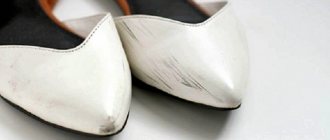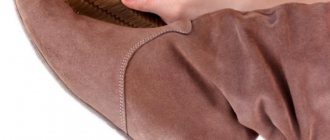The attractive appearance of a new pair of shoes is lost over time during use. One of the problems that arises is creases and folds.
This is not only an aesthetic defect, but also a factor that contributes to faster wear. There is a need to remove creases and restore the appearance of the pair.
We will tell you in this article how to remove creases from leather, suede, faux leather, and nubuck shoes.
Causes of the problem
The new shoes have a sleek upper and an attractive look. When walking, the leg in the foot constantly changes position, which leads to the appearance of bends on the surface. Even an expensive branded pair is not immune from this. But deep creases do not always occur.
The following factors contribute to this circumstance:
- low quality of the product (tailoring and materials);
- incorrectly selected size or model;
- violation of storage rules;
- wearing a pair in the wrong season for which it is intended;
- improper use and care.
The factor that contributes to the appearance of folds may be the model itself.
If a single piece of leather was used for manufacturing, then creases at the bend of the foot are more likely to appear than on shoes that were sewn from several small fragments, highlighting the toe. Another factor is incorrect selection of size and fullness. Creases appear more often in cases where:
- The last is too wide and the foot does not fit properly.
- The block, on the contrary, is too narrow, which leads to tension in the upper material that was not intended by the manufacturer.
Most often, creases form on shoes without heels, since in such a pair the foot bends more when walking.
Why do creases appear on shoes?
To begin with, we suggest understanding the causes of such defects.
When we see a pair in the store, especially the suede one, it looks perfect. And we want it to remain that way. But this is impossible. During walking, the position of the foot changes. The shoes, in turn, follow the movements of the foot, which is why creases appear in the toe area. On a note! More severe creases remain on shoes with flat soles.
If you wear your boots or shoes carefully, natural creases remain almost invisible. But if you treat your shoes incorrectly, do not clean them in a timely manner and store them carelessly, you risk leaving significant defects on them, which will then be difficult to get rid of.
How to fix the defect?
If a defect appears on your favorite pair, you need to take action to fix the problem. It is advisable to start working at a stage before the creases become too strong and noticeable. It is easier to eliminate shallow folds than large creases.
Shallow
Homemade recipes will help you cope with a problem that has just arisen. They are not difficult.
Paper and cream
In order to remove only emerging wrinkles, you must perform the following steps:
- Stuff the toe of the pair tightly with crumpled paper, socks, or insert spacers to straighten the surface.
- Apply shoe polish, paying attention to problem areas.
- Leave the steam until the cream dries.
- Clean up.
- Remove the stuffing.
Wax and tinting
If the dents are small at the bend, you can use shoe wax. This product will soften and nourish the surface. Tinting is also suitable. But a good effect will only be achieved if the product is selected very accurately in color.
Cream
An emollient cream will help remove emerging creases.
Procedure:
- Lubricate the surface of the shoes with cream.
- Leave for a quarter of an hour.
- Stuff the sock tightly with paper.
- Place the pair on their side.
- Continue treatment 2 times a day for 3 days.
- After the bend has straightened, the remaining cream must be removed from the surface with a napkin.
- Apply shoe wax.
- Clean up.
- Remove the paper.
Deep
In cases where the problem has worsened and the fold has become pronounced, more complex methods of influence will have to be used.
You need to prepare the following tools in advance:
- iron;
- cloth napkin (preferably microfiber);
- water;
- paper for stuffing (or special pads).
Work order:
Stuff the toe of the shoe with paper.- Moisten the cloth with water and wring it out.
- Place the napkin on the area with the crease, pressing firmly against the skin.
- Leave for a few minutes until the surface of the skin becomes slightly moisturized.
- Turn on the iron and set the heat to medium.
- Gently iron the crease area with a cloth.
- Leave the steam to stand until completely dry.
- Remove paper.
- Apply cream or wax to the surface.
- Carry out high-quality cleaning.
The sole of the iron should not be allowed to come into direct contact with the surface of the shoe; treatment is only permissible through the intervening fabric.
The process of processing shoes with creases can be seen in the video:
Ways to iron a leather skirt
According to experts, there are several methods for smoothing the skin.
Using steam
You can use a steam generator to straighten folds and creases. It is necessary to hang the skirt on hangers and treat it with a steamer several times at a distance of 15 to 20 centimeters, avoiding the formation of condensation. You can also get rid of wrinkles by hanging the item in the bathroom. To do this, you need to open the hot water tap so that the steam that rises from it sufficiently moisturizes the skirt to straighten out creases. The product must be kept in a damp room for at least an hour, then it can be hung to dry.
These methods are optimal for cases where clothing has decorative elements or pockets that interfere with ironing.
The main disadvantage of the steam ironing method is the long drying time; the skirt requires at least four days to dry completely. If the item has been treated with a moisture-repellent composition, after drying the procedure must be repeated, since this property is lost during steaming.
Iron
Smoothing a leather skirt with an iron is not an easy process and there is a high risk of damaging the product. It is recommended to act in stages:
- read the information on the product label in order to comply with the recommended temperature conditions;
- turn the skirt inside out and lay it out on an ironing board;
- place parchment paper or thick cloth under the product;
- smooth the item evenly without pressing on the iron or holding it in one place for a long time through a piece of damp cotton material;
- Carefully lay out the skirt while it cools so that new folds do not form;
- hang the product on a hanger.
If there is no label on the clothing or information necessary to care for the product, the minimum temperature of the iron is set.
By water
To smooth it, you need to put warm, preferably distilled water into a spray bottle and completely spray the item hanging on the hanger. After treatment, dry the skirt away from heat sources to avoid deformation.
Oil, Vaseline
Walnut and castor oils and Vaseline are excellent for straightening wrinkles on natural leather. To achieve the result, you need to apply an oily product to the folds and creases with a brush or by hand, wait for the desired effect and wipe off the remaining oil with a damp cloth. This method is one of the safest for the product; the structure of the material is restored, the skin is moisturized and takes on its original appearance.
Humidifier
There are special moisturizing sprays for treating leather products. To smooth a leather skirt with this product and protect it from the harmful effects of the environment, you need to:
- unfold it and straighten the folds;
- spray the spray on the item at a distance of at least 25 cm;
- spread with a soft cloth over the surface until completely absorbed into the skin;
- hang the skirt carefully on hangers.
With a sinker
To iron leather clothes, you can use a weight, which can be books, magazines or a press. To achieve the result you need:
- lay the item on a flat surface;
- put a piece of thin fabric on top of the skirt;
- press down with a press and leave until morning.
What to do with leatherette?
Artificial leather is significantly different in structure from natural leather, despite its external similarity. You should not use recipes that are suitable for natural materials for dermantin and eco-leather, as they will not be effective.
The artificial material does not contain fibers that can expand when softened with waxes and oils. Therefore, shoes with non-natural uppers must be taken care of regularly and thoroughly.
If the rules of storage and wearing are violated, the creases quickly become deep and practically irremovable. Leatherette shoes should be stored with inserts or lasts , avoiding even slight deformation. It is also necessary to use special care products.
DIY tread repair
The most vulnerable are the protectors located on the heels of shoes. To restore them, you will need a hard piece of rubber, which can be taken from the sole of unnecessary shoes. Among the tools and additional devices that will be useful for work are: shoe glue, a sharp knife, and coarse sandpaper. The tread repair process is as follows:
- A patch is cut out of a piece of hard rubber and fitted in place of the damaged or worn out tread.
- Using a knife and sandpaper, make a wedge-shaped patch.
- The surfaces that will be glued are treated with sandpaper to roughen them, and then wiped with a solvent and allowed to dry.
- The adhesive composition is applied in two layers to the patch and the future location of the protector. The drying time of the first layer should be about 20 minutes, the second - 4-6 hours.
- After the glue has dried, the surfaces are heated over the stove until a smell appears, applied to each other, squeezed tightly and held until cool and fixed.
Sneakers with retreads can be worn immediately after the repair is completed. If possible, it is recommended to wait a day before use to provide additional reliability.
How to properly connect a gas stove in an apartment, standards for self-installation
How to smooth suede and nubuck?
On suede and nubuck, folds may appear already in the first season of wearing shoes. But even on such complex material it is quite possible to eliminate defects.
To bring such a pair back to normal you will need:
- a special brush for suede with rubber bristles;
- damp cloth;
- hairdryer
Procedure:
Clean the surface from dirt and dust.- Insert the filler so that the outer surface of the shoe upper is smoothed.
- Carefully walk over suede (nubuck) with a special brush.
- Place a piece of damp cloth on top of the problem area.
- Turn on the hairdryer.
- Direct a stream of heated air onto the fold.
- Remove the rag.
- Let the shoes dry naturally.
Instead of a brush, you can use fine-grained sandpaper, but you need to use it even more carefully so as not to damage the pile.
Combination top repair
On sneakers with a combined upper made of synthetic material with foam padding or natural and artificial suede, the fabric most often damaged is in the toe area, where the shoe comes into contact with the toes. On the outside, this area can be protected by a rubber insert around which there is a mesh, which is typical for running models of sneakers.
Rules for applying plaster on walls using beacons with your own hands
If there is minor damage to the front of the shoe, a patch can be sewn on. If there are large holes, you need to prop up the seams, adjust the size and shape of a piece of durable nylon fabric and sew it in place.
Prevention measures
In order to preserve the appearance of your shoes for as long as possible and avoid creases, you should adhere to the following preventive measures:
- If expensive dress shoes are intended to be worn only indoors, they should not be used outdoors.
- You should put on a pair using a shoe horn.
- Natural materials (leather, nubuck, suede) must be protected from frequent contact with water.
- You need to put on your shoes after first unfastening the clasp.
- It is recommended to have at least 2 pairs of shoes for the season, and wear them every other day, giving each pair the opportunity to dry and air out. Otherwise, due to constant moisture and incomplete drying, the pair will last less.
- Shoes should be cleaned after every use outside.
- Do not use soap or aggressive cleaning agents to care for natural leather.
- It is recommended to dry shoes in a room with good air exchange.
- Cream and wax should only be applied to dry and clean shoe surfaces.
- Do not wear shoes that are not completely dry.
- Shoes should be stored after having been stuffed with paper in conditions where deformation is excluded. The best option is right in the box.
- If your shoes get too wet, they can lead to deformation of the upper, creases, and even cracks.
Timely proper care of shoes will extend their service life and preserve their appearance for a long time.
Useful tips
When restoring shoes that have lost their original appearance, you should know some of the subtleties of the procedures themselves.
- So, wax is used only in metal jars. If it is offered in the form of an aerosol, then in this case this thing is absolutely useless.
- It is best to use kitchen paper towels as shoe filler.
- To speed up drying of shoes, you can use a hair dryer.
- Before you start treating the surface with “liquid leather”, you should test it on a small area.
Recommendations
Expert advice will help you cope with the task quickly and without problems:
Before removing creases, shoes must be cleaned of dust and dirt.- You should purchase shoes in accordance not only with the size, but also with the appropriate fullness.
- In cases where you can’t deal with creases on your own, or you don’t have time for this, you can turn to a shoe workshop for help.
- You should not use shoe care products immediately before going outside. This must be done in advance so that the cream has time to absorb and act.
- For removing creases, silicone-based products are less effective than wax-based products. This is due to the fact that silicone does not moisturize the surface, but only gives it shine.
- The purchased shoe care products must match the shoes not only in color, but also in the texture of the material. Information about this is present on the packaging. For example, “for smooth leather”, “for nubuck”, etc.
Repairing boots at home
If the sole of your shoes has become unusable, then proceed to repair it. The most effective means include special glue for shoe restoration. To work, you will also need a knife, alcohol, clean cloth, newspaper, and a bag.
Lay out newspaper as a work surface. Clean the sole with a cloth soaked in alcohol solution
If possible, scrape off the old glue with sandpaper. Important! Read the instructions for using the glue
Focus on safety precautions. Some products evaporate hazardous emissions, so open all windows in advance and ensure adequate ventilation. Apply glue on all sides so that it is evenly distributed over all irregularities
Apply pressure to the torn areas. Use alcohol to remove adhesive
Apply glue on all sides so that it is evenly distributed over all irregularities. Apply pressure to the torn areas. To remove glue, use alcohol-based products.
This is interesting: Tips from professionals: how to stretch shoes if they are too tight
Wrap the shoes in a bag and weigh them down with a heavy weight, for example, a book. Check that the tear area is carefully pressed. Leave the glue to dry for two days.

